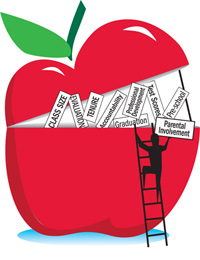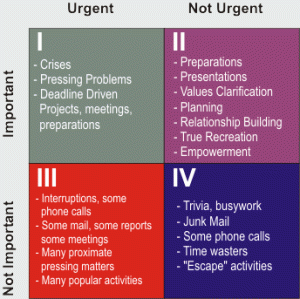I’m not sure what my principal thought when I walked into his office a few years back with a poster board under my arm, declaring that I must “stay in the second quadrant.” I had shaped perpendicular lines into four quadrants on the board and told him that I would take on the role of English Department Chair if and only if I could spend most of my time in the second quadrant. No, the second quadrant wasn’t some higher plane of being; it wasn’t hippy jargon or
 some metaphorical proclamation. It was a part of a time-management strategy I’d learned from best-selling management guru, Stephen Covey, whose Seven Habits of Highly Successful People has become perhaps the quintessential self help book.
some metaphorical proclamation. It was a part of a time-management strategy I’d learned from best-selling management guru, Stephen Covey, whose Seven Habits of Highly Successful People has become perhaps the quintessential self help book.
Covey has been on my mind again lately as I notice how the demands on a teacher’s time are increasing exponentially with no end in sight. Applying Covey’s time matrix to a teacher’s day clarifies what’s happening in the current educational climate and suggests what this means for the future of teachers, students and the state of education.
First, the matrix. Covey’s quadrants use “urgency” and “importance” as filters to examine how we spend our time: Do we spend our time wisely? Do we focus on long term goals? Or are we constantly in emergency mode, neglecting what’s most important?
Here’s my take on a teacher’s schedule in four-quadrant form:
Quadrant 1: Urgent & Important
- This is where teachers spend 80% of their time.
- Often preparing for 5 or 6 sections of 4 or 5 different courses, with a single hour of preparation time provided per day, teachers are generally operating in emergency mode, struggling to stay on top of “What am I doing in class today?” much less tomorrow, next week, or next month.
- In the moments they are not sprinting to keep up with the teaching part
 of their day, they are trying to manage the needs (make up work, test corrections, extra 1-on-1 help, parent calls etc) of 125+ students while trying to also keep on top of grading and returning those 125+ students’ assignments and assessments with timely and meaningful feedback.
of their day, they are trying to manage the needs (make up work, test corrections, extra 1-on-1 help, parent calls etc) of 125+ students while trying to also keep on top of grading and returning those 125+ students’ assignments and assessments with timely and meaningful feedback.
Quadrant 2: Important & Not Urgent
(insert crickets chirping)
- Few teachers have the luxury of spending any time in quadrant 2.
- This is a tragedy with enormous repercussions because this is where innovation happens, where vision comes into play, where planning allows significant change, where reflection makes room for improvement, where new ideas germinate. Without quadrant 2, we can all but forget about meaningful reform, about improving classroom practices, about increasing student learning.
Quadrant 3: Urgent & Not Important
- This is where where teachers spend 20% of their time.
- This is where we process paperwork not tied to what happens in the classroom.
- This is where we attend meetings not related to what happens in the classroom.
- This is where we jump through state and federally mandated hoops not directly related to what happens in the classroom.
- This is the single most frustrating part of education today.
Quadrant 4: Not Urgent & Not Important
- This simply doesn’t happen in schools today; there is no extra time, so there is no wasted time. There is no down time, period.
- Teachers are lucky if they have a chance to take a bathroom break much less eat lunch.
- The days of faculty lounge camaraderie---crowded tables of teacher chat during lunch---are over. Most teachers now eat their lunches in their classrooms while swimming in quadrant 1.
Stephen Covey contends that most people erroneously spend the majority of their time in quadrants 1 and 4 (in emergency and trivia modes) when they should be spending most of their time in quadrant 2, where the big picture stuff happens. He says to live a life consistent with your mission, your values, your goals, you need to spend the majority of your time in quadrant 2.
That was why I walked into my principal’s office with that poster board under arm. If I was to take on an added responsibility, I needed it to reside in quadrant 2. I wanted to create a larger vision for the English Department. I wanted to do more than just complete forms, order supplies, and manage department drama.
Though Covey convincingly touts its importance, time spent in the second quadrant seems like a pipe dream for educators today. I can remember clear as day a couple years ago when a colleague of mine returned from a conference completely excited about a technique she believed would revolutionize the way she taught her content. “I have got to do this!” she exclaimed. Her enthusiasm was contagious and I found myself affirming her, “Yes, you absolutely do!”
Flash forward to today. This colleague of mine, who regularly has 5 different courses to prep in multiple buildings, some of them split classes, has not incorporated that method into her classroom practice. She is an excellent teacher, among the best in the district, but like the majority of teachers today, she is stuck in quadrant 1. If she were afforded time in quadrant 2, she and all of her students would now be reaping the benefits of that idea she was so convinced would revolutionize her teaching. 

Simply put, teachers today are stuck in the first quadrant and the increasing demands being placed on their time will only continue to thicken the wall between quadrants 1 and 2.
Stephen Covey: If you’re reading this, give Arne Duncan and the Dept. of Education a call, perhaps a free consult. Tell them that until they create an environment which allows teachers to step out of emergency mode, until they find a way to allow teachers to catch their breath, reflect, envision, and create, any attempts at meaningful school reform are futile.
